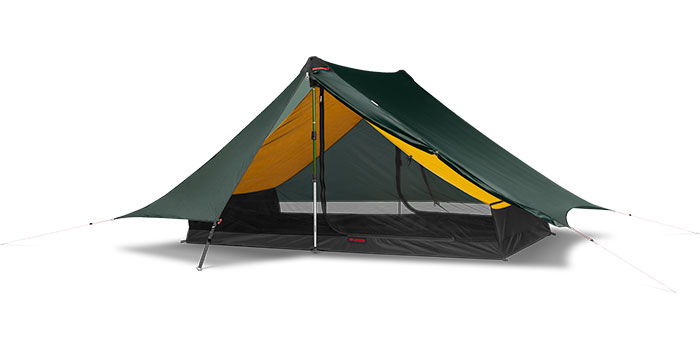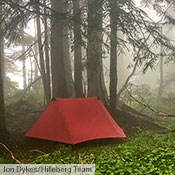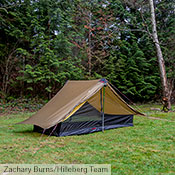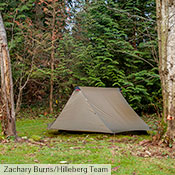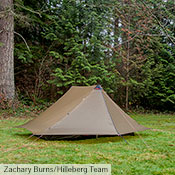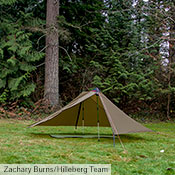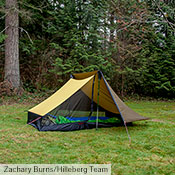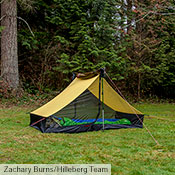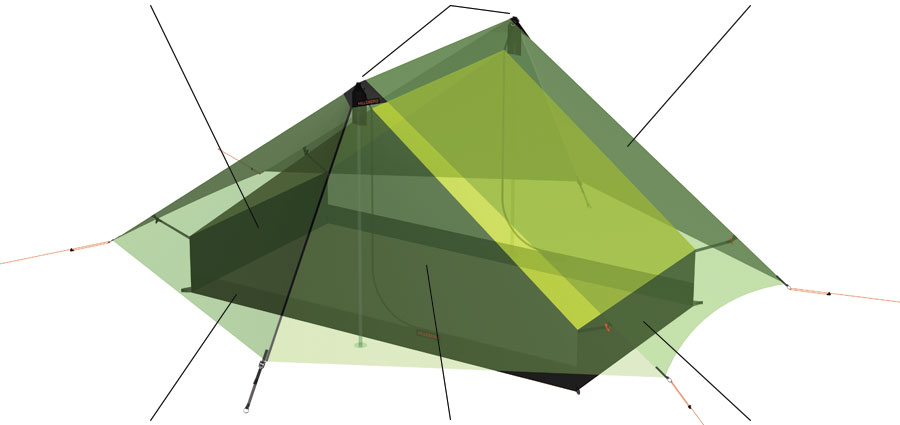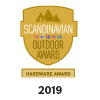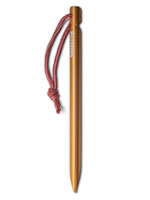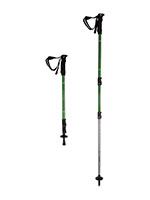At first glance, the Anaris is simply a lightweight ridge tent that pitches with trekking poles and is a welcome addition to our Yellow Label, 3-season/snow-free tent series. But in reality, the Anaris follows a direct genetic line from our very first tent, integrates material and construction elements from a wide range of both past and current Hilleberg tents and shelters, and is in many ways a reflection of both the history and the soul of Hilleberg itself.
The Anaris takes its basic shape from the Keb, Hilleberg’s first tent, introduced in 1973. And while the Keb pioneered our linked inner and outer tent concept, it was also the platform for some of the innovations that have come to define all Hilleberg tents, including the ability to separate the inner and outer tents, and the adoption of the silicone-coated fabrics that Hilleberg began using exclusively in the late 70s. And while Bo and the company went on to develop tunnel and dome tents, ridge tents always had a place.
The Keb evolved into the first Anaris, in the line from the mid-80s to the mid 90s, and the namesake of the current model. The early mid-2000s saw the Muddus ridge tent that used our zip-together modular system (which we still use in our large Stalon XL group tent), and the Rajd, a ridge-style shelter built with a single wall of Kerlon 1200 and made to be pitched with trekking poles. “Both the Muddus and the Rajd were great ideas,” says Bo, “but they were not fully realized. The Muddus was very roomy, and its modular construction let you make an awning out of the side wall, creating a kind of airy ‘super tarp’ that was reminiscent of our older Muddus three-sided shelter. And the Rajd was indeed very light, but it its single wall construction had some disadvantages.”
That first Muddus Bo speaks of was a very simple, floorless wind shelter with a roof and three sides that was in our line in the mid-80s to early 90s. “It was our version of the Swedish ‘gapskjul,’” says Bo, “but with a full mesh front. It was perfect for summer and fall forest backpacking trips, and you felt incredibly close to nature in it.” This Muddus and our tarps, which have been in our line since the mid-80s, set the trajectory that led to our Mesh Ridge and Mesh Box shelters introduced in 2012 and to our Tarp 5 and Mesh Tent 1, which came out in 2016 and 2018 respectively. The simplicity, light weight and airy nature of these shelters all contributed significantly to the project that became the 2020 Anaris.
“We took everything we have learned about building great tents and shelters and put that into the new Anaris,” says Petra Hilleberg, Hilleberg’s President and CEO. “After the success of our Yellow Label models, we realized that a Yellow Label ridge tent would be the perfect thing to explore.” We started with easy-to-pitch and roomy design of the Keb/Anaris and combined it with both the simplicity of trekking pole set up from the Rajd, and the airiness of the Tarp 5/Mesh Tent 1 combination. We took elements from both the Muddus wind shelter and the Muddus ridge tent, combining the close-to-nature feel of the first Muddus and incorporating the ‘super tarp’ capability from the Muddus ridge tent. “You can roll up the vestibules and the sides of the Anaris’s outer,” says Petra, “so you can get as much or as little air flow as you want. And you can do this with both the full tent and when you use the outer tent on its own.”
Perhaps most importantly, however, is that the Anaris is a true Hilleberg tent. “We have a standard of quality, strength, and comfort that we will not compromise on,” says Bo, “whether that’s for a tunnel, dome or ridge tent. Hilleberg might be best known for our tunnel tents – especially the Keron – and our dome tents, but we have lots of experience with ridge tents, as well, and they have been a part of who we are and what we do.”
At first glance, the Anaris is simply a lightweight ridge tent that pitches with trekking poles and is a welcome addition to our Yellow Label, 3-season/snow-free tent series. But in reality, the Anaris follows a direct genetic line from our very first tent, integrates material and construction elements from a wide range of both past and current Hilleberg tents and shelters, and is in many ways a reflection of both the history and the soul of Hilleberg itself.
The Anaris takes its basic shape from the Keb, Hilleberg’s first tent, introduced in 1973. And while the Keb pioneered our linked inner and outer tent concept, it was also the platform for some of the innovations that have come to define all Hilleberg tents, including the ability to separate the inner and outer tents, and the adoption of the silicone-coated fabrics that Hilleberg began using exclusively in the late 70s. And while Bo and the company went on to develop tunnel and dome tents, ridge tents always had a place.
The Keb evolved into the first Anaris, in the line from the mid-80s to the mid 90s, and the namesake of the current model. The early mid-2000s saw the Muddus ridge tent that used our zip-together modular system (which we still use in our large Stalon XL group tent), and the Rajd, a ridge-style shelter built with a single wall of Kerlon 1200 and made to be pitched with trekking poles. “Both the Muddus and the Rajd were great ideas,” says Bo, “but they were not fully realized. The Muddus was very roomy, and its modular construction let you make an awning out of the side wall, creating a kind of airy ‘super tarp’ that was reminiscent of our older Muddus three-sided shelter. And the Rajd was indeed very light, but it its single wall construction had some disadvantages.”
That first Muddus Bo speaks of was a very simple, floorless wind shelter with a roof and three sides that was in our line in the mid-80s to early 90s. “It was our version of the Swedish ‘gapskjul,’” says Bo, “but with a full mesh front. It was perfect for summer and fall forest backpacking trips, and you felt incredibly close to nature in it.” This Muddus and our tarps, which have been in our line since the mid-80s, set the trajectory that led to our Mesh Ridge and Mesh Box shelters introduced in 2012 and to our Tarp 5 and Mesh Tent 1, which came out in 2016 and 2018 respectively. The simplicity, light weight and airy nature of these shelters all contributed significantly to the project that became the 2020 Anaris.
“We took everything we have learned about building great tents and shelters and put that into the new Anaris,” says Petra Hilleberg, Hilleberg’s President and CEO. “After the success of our Yellow Label models, we realized that a Yellow Label ridge tent would be the perfect thing to explore.” We started with easy-to-pitch and roomy design of the Keb/Anaris and combined it with both the simplicity of trekking pole set up from the Rajd, and the airiness of the Tarp 5/Mesh Tent 1 combination. We took elements from both the Muddus wind shelter and the Muddus ridge tent, combining the close-to-nature feel of the first Muddus and incorporating the ‘super tarp’ capability from the Muddus ridge tent. “You can roll up the vestibules and the sides of the Anaris’s outer,” says Petra, “so you can get as much or as little air flow as you want. And you can do this with both the full tent and when you use the outer tent on its own.”
Perhaps most importantly, however, is that the Anaris is a true Hilleberg tent. “We have a standard of quality, strength, and comfort that we will not compromise on,” says Bo, “whether that’s for a tunnel, dome or ridge tent. Hilleberg might be best known for our tunnel tents – especially the Keron – and our dome tents, but we have lots of experience with ridge tents, as well, and they have been a part of who we are and what we do.”

 Cart
Cart






